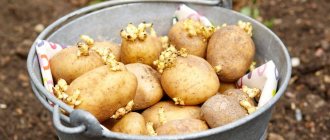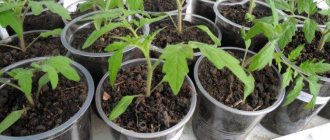Vegetable growers have been growing Podarok cabbage in their gardens for decades. Despite the large number of new varieties and hybrids of this vegetable crop developed in recent years, the Podarok variety is still popular among Russian summer residents from many Russian regions.
We will talk about the main characteristics of this variety, the nuances of cultivation, advantages and much more in this article.
History of variety development
This variety was bred by breeders working at the Gribov experimental station at the beginning of the second half of the last century. Podarok cabbage was added to the State Register of the USSR in 1961. This variety was bred specifically for cultivation on an industrial scale, but this cabbage is also successfully grown on private farms.
The variety is recommended for cultivation throughout almost the entire territory of Russia, except for the regions of the Far North and a number of other cold areas.
Advantages
The cabbage variety Podar has almost no drawbacks. It only requires good watering, fertile soil and protection from certain types of pests. Advantages of the variety:
- excellent growth and product yield even in unfavorable climatic conditions;
- stable yield;
- Fresh cabbage can be stored for up to 5 months without losing its taste;
- excellent taste and presentation;
- excellent transportability;
- the best variety for pickling and pickling;
- resistance to various diseases;
- cold resistance;
- the heads of cabbage do not crack.
The culture loves light and moisture. It should not be planted in a shaded area of the site. Podarok cabbage can be planted with seeds in open ground; it is resistant to sudden temperature changes. In addition, Podarok cabbage is heat-resistant; it ripens in the first month of autumn.
Main characteristics of the variety
This cabbage variety is classified as a mid-late variety - 120-135 days pass from the moment of seed germination to harvest. And when growing a plant in seedlings, ripe heads of cabbage can be cut off in late August - early September.
Heads of cabbage are considered ripe when they have reached the expected size and are firm to the touch. The bushes of the variety are powerful, the foliage is corrugated, gray with a greenish tint, collected in a raised rosette. The covering leaves and foliage of the rosette are covered with a waxy coating.
The heads of cabbage are round, slightly flattened, dense when fully ripe. Their weight can reach 3.5-5.5 kg. Kocherygi (external and internal) are of medium length, up to 18-19 cm. The internal foliage of the heads of cabbage is white with a greenish tint.
Typically, this cabbage is planted according to a 0.6 * 0.6 m pattern, while the yield of the Podarok variety can be up to 9 kg per square. The harvested crop has an excellent presentation and good taste. The sugar content in ripe cabbage is up to 6.2%. Ripe heads of cabbage are of universal use; they are used fresh, for preparing hot dishes, pickling and pickling.
The harvested crop can easily withstand transportation over long distances, and the heads of cabbage are not prone to cracking. The shelf life of this cabbage under appropriate conditions is until spring. It is better to hang them for storage in the cellar by the stumps, and the cabbage should not touch.
Cabbage of this variety is resistant to most diseases characteristic of other cabbage varieties.
Description of the cabbage variety Gift
The head of cabbage has an oblong shape and is medium in size. The leaves are round in shape, do not fit tightly to each other, and are slightly raised at the top of the head. They have a brown-green color and a pronounced waxy coating. The edge of the sheet is almost smooth, with a slight wave. This description of Podarok cabbage is given by breeders.
The head of cabbage has a round shape and a dense structure, its weight ranges from 2 to 4 kg. In cross section it is white with a greenish tint. The length of the stalk is approximately 20 cm.
The Gift variety is considered medium late. Thanks to its dense structure, cabbage retains its good presentation for a long time and does not crack during ripening.
Important! The Podarok cabbage variety tolerates transportation well and does not spoil for a long time on the road.
Landing
For planting, you should choose areas that are illuminated by sunlight throughout the day. Even partial shading during the day leads to a deterioration in the taste of the heads of cabbage and the yield in general.
The main thing is to follow the rules of crop rotation and not plant cabbage in beds where other cruciferous vegetable plants grew in the previous season. The best predecessors for Podarok cabbage are cucumbers, peas, beans and soybeans.
The soil must be fertile; cabbage especially loves organic fertilizers. Soil acidity is neutral or slightly alkaline. On acidic soils, this vegetable plant can be affected by clubroot. Therefore, if the soil on the site is highly acidified, it should be limed in the fall by adding lime or dolomite flour.
It is necessary to prepare a place for planting cabbage in the autumn. When digging, humus or compost is added to the soil at the rate of 20 kg per square area. In the spring, when digging, superphosphate and potassium salt are added (2 tablespoons per 1 m2 of area). And when planting, add 2 tbsp to the holes. l. urea and 100 g of wood ash.
Agrotechnics of cultivation
Cabbage Podarok loves well-lit, warm, windless areas. It is better to plant it away from fences or houses. Legumes, pumpkin, nightshade are good precursors for this variety. The soil should be fertile, high in humus, breathable, slightly alkaline or neutral in pH.
Acidic soils often cause clubroot to develop. Therefore, such soils must be limed.
Since autumn, the soil in the selected area has been prepared for planting cabbage. Add 5 kg/1 m2 of humus or rotted manure to the soil and dig it up. You can also add 30 g of potassium sulfate or superphosphate. In the spring, before planting seedlings on a bed, the soil is additionally fertilized with 30 g of urea and 1 tbsp. l. ash per 1 m2.
Since Podarok is a mid-late variety, it is cultivated only by growing seedlings. Sowing of seeds is carried out in the last days of April or early May - approximately 45 days before planting. In general, the timing depends on the climate of a particular region.
Planting material must be prepared - cabbage seeds are kept in hot (50 degrees) water for a quarter of an hour, then rinsed with cold water for about 5 minutes. This procedure is carried out to prevent phomosis. Then the planting material is soaked in growth stimulants or melt water for 18 hours. As soon as the seeds swell, they are immediately planted.
A nutritious soil mixture is prepared for seedlings - universal soil for seedlings is mixed with turf soil and sand in a 1:1:1 ratio. Ash is added to it at the rate of 1 tbsp. l./kg. You can also mix 75% peat, 5% coarse sand and 20% turf soil. Next, the soil is spilled with potassium permanganate (1%) or steamed for the purpose of disinfection. Immediately before planting, water the soil - the main thing is not to over-moisten it.
If the seeds are planted in a common box, they are planted in furrows with a row spacing of about 5 cm to a depth of 0.5-1 cm. But in this case, picking will be required. It’s easier to immediately place the seeds in separate peat cups. But in the first case, the root system of the seedlings will be more developed. 2-3 seeds should be planted in cups.
The container with seedlings is placed in a bright place; if necessary, additional planting can be arranged on cloudy days. The optimal temperature for seedlings is +18 degrees. The first sprouts will appear after a week. After this, the room temperature decreases for 5-7 days to +8 °C, then it is raised to 14-18 °C. In cups where several sprouts have grown, thinning is required by removing weak plants.
Watering the seedlings should be moderate. If you overfill it, then there is a high risk of developing blackleg, and the cabbage will no longer be saved from it.
If necessary, picking is carried out no earlier than the cabbage has its first true leaf. During transplantation, the central root is pinched, and the plant is planted in an individual container, immersed in the soil up to the cotyledons. After picking, the cabbage is shaded.
The first feeding is done when the seedlings have 2 true leaves. It is best to combine watering and fertilizing. Many people also use foliar feeding. Fertilize the cabbage again before transplanting it outside. A couple of weeks before this, the seedlings begin to undergo hardening - they are taken out onto the street or balcony.
Transplantation into open ground is carried out no earlier than the cabbage has 4-5 leaves. Usually this is May or June. The age of the seedlings is 45-55 days. It is better to choose a cloudy day for this.
Cabbage bushes are planted in holes on a ridge according to a 60*60 or 70*40 cm pattern. They cannot be planted very close to each other. After planting, the holes are filled with soil, which is compacted. After this, the cabbage is watered under the root and covered with non-woven fabric for the first days.
Caring for cabbage The gift is not complicated, but it includes basic agricultural activities: watering, fertilizing, loosening, hilling and weeding. Watering is carried out at the rate of 2 l / bush in the morning or evening, as needed. The intensity of irrigation is increased during the formation of the head of cabbage.
Hilling cabbage is done twice during the growing season. The procedure is performed only after rain or watering. Fertilizing is applied once every 3 months:
- I – 14 days after planting (15 g urea/10 l, manure can be used - the main thing is that the fertilizer contains nitrogen);
- II – 21 days after the first feeding (superphosphate, potassium and ammonium sulfate (about 10-15 g) are mixed in equal quantities);
- III – used only in case of severe soil depletion. The same substances are taken as in the second feeding.
We recommend reading
Which type of cabbage to choose for pickling, pickling and storing for the winter
Schemes and rules for applying fertilizers to cabbage
Features and methods of storing white cabbage
Rules for planting cabbage in open ground
Care
Further care for cabbage consists of the following activities:
- In carrying out regular watering - in any weather, the soil in the beds with this vegetable plant should remain moist to a depth of 0.7 m.
- The next day after watering, it is recommended to loosen the soil around the cabbage, simultaneously removing all weeds.
- Fight “harmful” bugs in a timely manner, since during the growth period of young plants, pests are able to eat all the foliage very quickly. It is most effective to “dust” the aboveground part of the cabbage with a mixture of wood ash and tobacco dust.
Harvest and storage
The cabbage harvest begins in mid-October. Do this on a cool, dry day. The air temperature should be +4 °C..+7 °C. Heads of cabbage harvested on such a day will last much longer.
The cabbage plant needs to be pulled out by the roots from the ground, and the stump cut with a knife, leaving 3-4 cm. Loose heads of cabbage are put aside for pickling, dense ones are sent to the basement.
The air temperature in the storage should be 0..+5 °C, and the air humidity should be 90-98%. Hanging heads of cabbage by stumps is considered the best storage method. They shouldn't touch each other.
Heads of cabbage suspended by stumps
Reviews
On the Podarok cabbage variety forum, many vegetable growers leave their reviews about this vegetable plant. Some of them are given below.
Larisa, 45 years old, Moscow region : the seed material of this cabbage has almost 100% germination, so it is better to plant the seeds less often - otherwise it is difficult to plant thickened seedlings. The heads of cabbage grow dense and tasty. During the growth process, the bushes of this cabbage practically do not get sick, you just have to fight the cruciferous flea beetle, which often attacks the cabbage.
Irina, 50 years old, Kostroma region : We have been growing Podarok cabbage on our plot for decades. A good mid-late variety, I can’t say how it is stored, because I have nowhere to store it. But we prepare salted and sauerkraut from these heads of cabbage, and we eat it almost until the next season.
Oleg, 49 years old, Volgograd region : we are growing cabbage for sale, so we tried to grow different varieties and hybrids. However, many of them have too high a seed price, so it is not profitable to grow them for sale. But Podarok cabbage has a low price for seed material, and the germination rate is almost 100%, and the heads of cabbage grow large, dense, and are distinguished by the fact that they can lie for a long time, so they are sold out well.
Pest and disease control
It is important to carry out timely prevention of cabbage diseases and damage to the main types of cabbage pests. Among the harmless and traditional methods, one can highlight spraying with a solution of tobacco, ash, and garlic.
To prevent the appearance of cruciferous flea beetle, you can plant cabbage near tomatoes, onions or garlic. It is also necessary to regularly and thoroughly weed the cabbage bed.
To avoid damage to the fruit by the cabbage fly, you should fill the soil around the rhizome of the plant with ash. Black pepper is also effective. After adding these substances to the soil, it must be loosened.
The rhizomes and leaves of cabbage can be destroyed by snails and slugs. If the edges of the leaves are damaged, this is a sure sign of the appearance of these pests.
To combat them, use a solution that is prepared as follows:
- You need to take 0.5 liters of clean boiled water.
- Dilute mustard, ground black pepper, ash, salt in it - 2 tbsp each. l. each ingredient.
- In the morning, water the soil with the resulting mixture between the roots of the plants.
- In the evening, the liquid is sprayed on the fruit ovaries.
Important! Spraying is carried out on a clear day when rain is not expected.
The solution must remain on the plant for at least 5 hours. After a week, the treatment should be repeated.
How to grow a Gift?
You can sow seeds as early as late April or early May. You should adhere to a 5x5 cm planting pattern. Seeds should be planted in the ground to a depth of 1-1.5 cm. After a week, the first shoots appear. When 4-5 true leaves appear on the plant, it is ready to be transplanted into open ground. This happens in May - early June.
As a rule, on day 45 the seedlings are ready to move. The optimal distance for planting is 60x60 cm. Plants should not be close to each other. Before planting, it is necessary to harden the seedlings by leaving them in the fresh air for several days.
The fruits become ripe on the 125th day from the appearance of the first shoots. The harvest is harvested in September-October as it ripens. The best predecessors for cabbage: legumes, cucumber and potatoes.
When caring for cabbage, you need to ensure thorough watering, weeding and loosening of the soil. And don’t forget about fertilizing and hilling. Plants should not be allowed to stretch. By following simple rules, you can collect from one square. m. up to 10 kg of harvest.
The benefits of white cabbage
With a low calorie content - only 27 kcal per 100 g of product, this vegetable is rich in a variety of vitamins, the most significant of which are vitamins C and K. This vegetable also has a rich mineral composition: 20 macro and microelements, including potassium, calcium, so necessary for humans, iodine, selenium, zinc, molybdenum and cobalt. It contains a lot of dietary fiber, which regulates the digestion process. It also contains carbohydrates (about 4% on average), thanks to which cabbage lends itself well to pickling.











